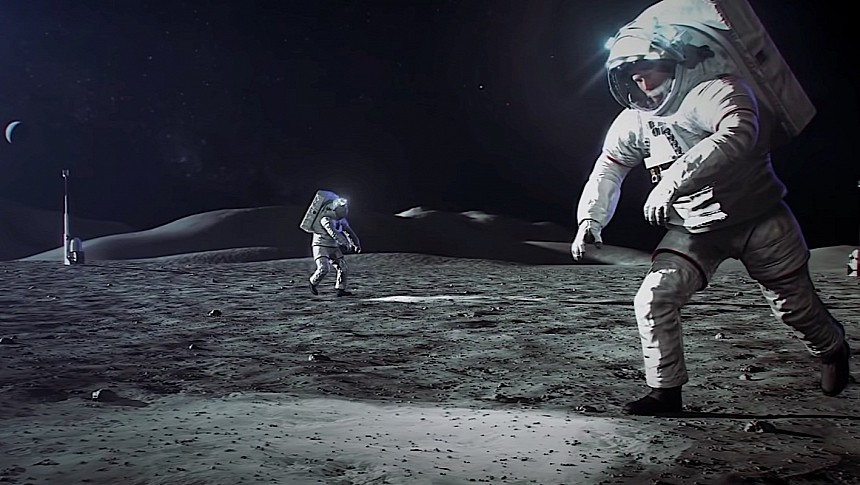Until yesterday, January 9, 2024, the world was bracing for the first crewed mission around the Moon by the end of the year and the first Moon landing of humans by the end of the next one. But then NASA stepped forward and pushed everything back by almost a year, compared to its initial plans.
January 9 was a sort of a bad day in the history of space exploration. The Peregrine lander, the first such piece of tech to be sent by America to the Moon in more than five decades, has suffered a fuel leak, which makes the arrival at its destination impossible. And then NASA broke the news about the Artemis mission.
Word that crews will not be orbiting and landing on the Moon anytime soon did not come out of the blue, and we were frankly kind of expecting that to happen. After all, we know SpaceX is behind with getting the Starship lander for Artemis III ready, and NASA isn't doing any better with its own tech either.
During a press conference held yesterday, the agency's top brass announced the move citing the need to ensure safety for the crews. As you'll see further down, they are not telling us the exact reasons behind the postponement, and only give us a vague idea of what's going on over there.
We'll start with Artemis II, the second mission of the program, and the first one to carry humans, including the first woman to go on a mission to the Moon, the first person of color, and the first non-American (Reid Wiseman, Victor Glover, Christina Hammock Koch, and Jeremy Hansen).
The mission was scheduled to take off in November 2024 and take its crew on a ten-day trip around the Moon, one that would have taken them to the furthest point in space humans have ever reached, 6,400 miles (10,300 km) beyond the lunar surface.
The mission profile hasn't changed, but its tentative launch date has. According to NASA, the new date is now September 2025.
NASA says it chose to push the mission so far back because it needs to ensure the safety of the crew. More to the point the agency claims to have bumped into a series of issues "that require additional time to resolve."
It's unclear exactly what these issues are, and how massive they are, as NASA only said something about a battery problem and challenges with a circuitry component that takes care of air ventilation and temperature control.
And there is also the issue of the "unexpected loss of char layer pieces" during the reentry of the Orion spacecraft used in the Artemis I mission. The space agency does not say exactly what the investigation found (full results are expected later in the spring), but it probably is nothing good.
The postponement of the Artemis II mission does the same for the Artemis III one, the flight that would have actually landed humans on the Moon. Initially scheduled to take off and land in late 2025, the mission is now planned to do this in September 2026.
Only the third crewed mission of the program, Artemis IV, is still on track for its scheduled launch date, which remains 2028.
The new dates also affect the timeline for the Gateway lunar space station. The launch of the first elements was scheduled for October 2025, but now the agency is looking for new dates in the calendar for the assembly missions to begin, so that they are better aligned with Artemis IV, the first mission to the Gateway.
NASA does not blame any of its commercial partners for the delays. Quite the opposite, it tries to paint this postponement as a good thing, as both SpaceX, which is developing the lander for Artemis III, and Axiom Space, which is making the spacesuits for the same mission, will have more time on their hands to finetune their designs.
Many of you looking forward to the Artemis program really taking off are probably disappointed at the news. You do have to take into account though the fact Artemis is the most complex human space exploration program ever devised. And the most daring, too.
If all goes well, Artemis will literally open the doors for humanity's colonization of the Moon (for scientific purposes, but still), but also for the first crewed mission to Mars, the Holy Grail of the solar system.
As Amit Kshatriya, NASA's Moon to Mars Program Office manager says, "Artemis is a long-term exploration campaign to conduct science at the Moon with astronauts and prepare for future human missions to Mars. That means we must get it right as we develop and fly our foundational systems so that we can safely carry out these missions."
So it's probably worth the extra wait, don't you think?
Word that crews will not be orbiting and landing on the Moon anytime soon did not come out of the blue, and we were frankly kind of expecting that to happen. After all, we know SpaceX is behind with getting the Starship lander for Artemis III ready, and NASA isn't doing any better with its own tech either.
During a press conference held yesterday, the agency's top brass announced the move citing the need to ensure safety for the crews. As you'll see further down, they are not telling us the exact reasons behind the postponement, and only give us a vague idea of what's going on over there.
We'll start with Artemis II, the second mission of the program, and the first one to carry humans, including the first woman to go on a mission to the Moon, the first person of color, and the first non-American (Reid Wiseman, Victor Glover, Christina Hammock Koch, and Jeremy Hansen).
The mission was scheduled to take off in November 2024 and take its crew on a ten-day trip around the Moon, one that would have taken them to the furthest point in space humans have ever reached, 6,400 miles (10,300 km) beyond the lunar surface.
The mission profile hasn't changed, but its tentative launch date has. According to NASA, the new date is now September 2025.
It's unclear exactly what these issues are, and how massive they are, as NASA only said something about a battery problem and challenges with a circuitry component that takes care of air ventilation and temperature control.
And there is also the issue of the "unexpected loss of char layer pieces" during the reentry of the Orion spacecraft used in the Artemis I mission. The space agency does not say exactly what the investigation found (full results are expected later in the spring), but it probably is nothing good.
The postponement of the Artemis II mission does the same for the Artemis III one, the flight that would have actually landed humans on the Moon. Initially scheduled to take off and land in late 2025, the mission is now planned to do this in September 2026.
Only the third crewed mission of the program, Artemis IV, is still on track for its scheduled launch date, which remains 2028.
The new dates also affect the timeline for the Gateway lunar space station. The launch of the first elements was scheduled for October 2025, but now the agency is looking for new dates in the calendar for the assembly missions to begin, so that they are better aligned with Artemis IV, the first mission to the Gateway.
Many of you looking forward to the Artemis program really taking off are probably disappointed at the news. You do have to take into account though the fact Artemis is the most complex human space exploration program ever devised. And the most daring, too.
If all goes well, Artemis will literally open the doors for humanity's colonization of the Moon (for scientific purposes, but still), but also for the first crewed mission to Mars, the Holy Grail of the solar system.
As Amit Kshatriya, NASA's Moon to Mars Program Office manager says, "Artemis is a long-term exploration campaign to conduct science at the Moon with astronauts and prepare for future human missions to Mars. That means we must get it right as we develop and fly our foundational systems so that we can safely carry out these missions."
So it's probably worth the extra wait, don't you think?
























